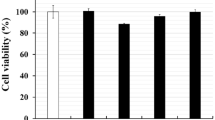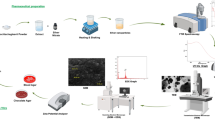Abstract
Ciprofloxacin induced an increment of reactive oxygen species in sensitive strains of Staphylococcus aureus leading to oxidative stress detected by chemiluminescence while resistant strains did not suffer such stress. Oxidation of lipids was performed by employing thiobarbituric acid reaction to detect the formation of the amplified intermediate between reactive species oxygen and cytoplasmic macromolecules, namely malondialdehyde (MDA). The sensitive strain presented higher peroxidation of lipids than the resistant strain. The oxidative consequence for DNA was investigated by means of bacteria incubation with ciprofloxacin and posterior extraction of DNA, which was studied by high performance liquid chromatography (HPLC). Sensitive S. aureus ATCC 29213 showed an increase of 8-oxo-7,8-dihydro-2′-deoxyguanosine (8-oxodG) respect controls without antibiotic; there was evident increase of the ratio between 8-oxodG and deoxyguanosine (dG) as a consequence of oxidation of dG to 8-oxodG considered the major DNA marker of oxidative stress. The resistant strain showed low oxidation of DNA and the analysis of 8-oxodG/dG ratio indicated lesser formation of 8-oxodG than S. aureus ATCC 29213.
Similar content being viewed by others
References
Cabiscol E, Tamarit J, Ros J: Oxidative stress in bacteria and protein damage by reactive oxygen species. Int Microbiol 3: 3–8, 2000
Yoon SJ, Park JE, Yang JH, Park JW: OxyR regulon controls lipid peroxidation-mediated oxidative stress in Escherichia coli. J Biochem Mol Biol 35: 297–301, 2002
Lee HS, Lee YS, Kim HS, Kim HS, Choi JY, Hassan HM, Chung MH: Mechanism of regulation of 8-hydroxyguanine endonuclease by oxidative stress: Roles of FNR, ArcA, and Fur. Free Radic Biol Med 24: 1193–201, 1998
Johnson KA, Mierzwa ML, Fink SP, Marnett LJ: MutS recognition of exocyclic DNA adducts that are endogenous products of lipid oxidation. J Biol Chem 274: 27112–27118, 1999
Kiley PJ, Storz G: Exploiting thiol modifications. PLoS Biol 2: e400, 2004
Becerra MC, Albesa I: Oxidative stress induced by ciprofloxacin in Staphylococcus aureus. Biochem Biophys Res Commun 297: 1003–1007, 2002
Gurbay A, Gonthier B, Daveloose D, Favier A, Hincal F: Microsomal metabolism of ciprofloxacin generates free radicals. Free Radic Biol Med 30: 1118–1121, 2001
Spratt TE, Schultz SS, Levy DE, Chen D, Schluter G, Williams GM: Different mechanisms for the photoinduced production of oxidative DNA damage by fluoroquinolones differing in photostability. Chem Res Toxicol 12: 809–815, 1999
Belvedere A, Bosca F, Catalfo A, et al.: Type II guanine oxidation photoinduced by the antibacterial fluoroquinolone Rufloxacin in isolated DNA and in 2′-deoxyguanosine. Chem Res Toxicol 15: 1142–1149, 2002
Cadet J, Bellon S, Berger M, Cuquerella MC, de Guidi G, Miranda MA: Recent aspects of oxidative DNA damage: guanine lesions, measurement and substrate specificity of DNA repair glycosylases. Biol Chem 383: 933–943, 2002
Albesa I, Becerra MC, Battan PC, Paez PL: Oxidative stress involved in the antibacterial action of different antibiotics. Biochem Biophys Res Commun 317: 605–609, 2004
Barriere C, Centeno D, Lebert A, Leroy-Setrin S, Berdague JL, Talon R: Roles of superoxide dismutase and catalase of Staphylococcus xylosus in the inhibition of linoleic acid oxidation. FEMS Microbiol Lett 201: 181–185, 2001
Lee MH, Park JW: Lipid peroxidation products mediate damage of superoxide dismutase. Biochem Mol Biol Int 35: 1093–1102, 1995
Plastaras JP, Riggins JN, Otteneder M, Marnett LJ: Reactivity and mutagenicity of endogenous DNA oxopropenylating agents: base propenals, malondialdehyde, and N(epsilon)-oxopropenyllysine. Chem Res Toxicol 13: 1235–1242, 2000
Lhiaubet-Vallet V, Sarabia Z, Hernandez D, Castell JV, Miranda MA: In vitro studies on DNA-photosensitization by different drug stereoisomers. Toxicol In Vitro 17: 651–656, 2003
Becerra MC, Eraso AJ, Albesa I: Comparison of oxidative stress induced by ciprofloxacin and pyoverdin in bacteria and in leukocytes to evaluate toxicity. Luminescence 18: 334–340, 2003
Becerra MC, Sarmiento M, Paez PL, Arguello G, Albesa I: Light effect and reactive oxygen species in the action of ciprofloxacin on Staphylococcus aureus. J Photochem Photobiol B 76: 13–18, 2004
Author information
Authors and Affiliations
Corresponding author
Rights and permissions
About this article
Cite this article
Becerra, M.C., Páez, P.L., Laróvere, L.E. et al. Lipids and DNA oxidation in Staphylococcus aureus as a consequence of oxidative stress generated by ciprofloxacin. Mol Cell Biochem 285, 29–34 (2006). https://doi.org/10.1007/s11010-005-9051-0
Received:
Accepted:
Published:
Issue Date:
DOI: https://doi.org/10.1007/s11010-005-9051-0




